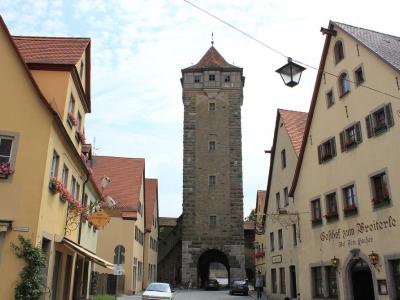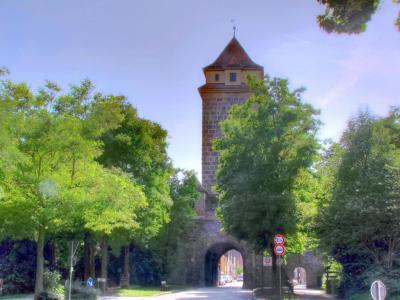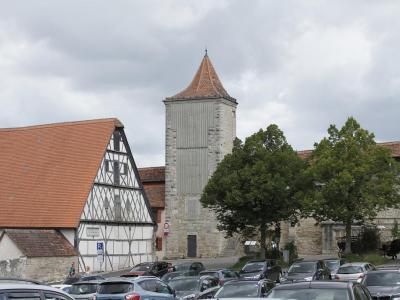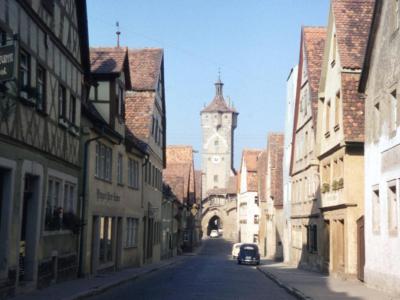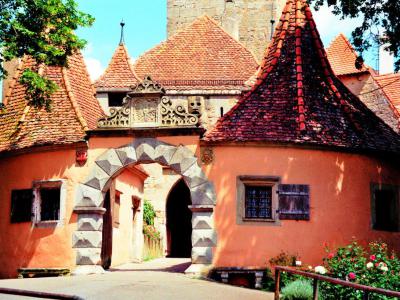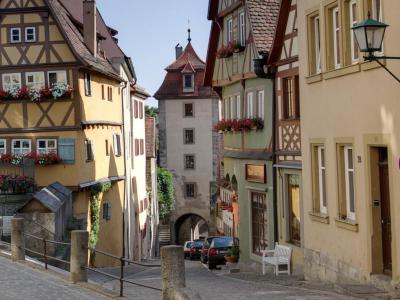
Old Town Gates and Towers Walking Tour (Self Guided), Rothenburg
The impressive walls surrounding the charming medieval town of Rothenburg showcase a series of distinct gates and towers, each with its unique story and significance.
These fortifications were built in the 14th century to protect the town from outside threats and today serve as one of its most iconic landmarks. Stretching for approximately four kilometers, the stone walls have been carefully maintained over the centuries, with due repairs and renovations performed as needed.
Visitors to Rothenburg can walk along the top of the walls and enjoy stunning views of the town and surrounding countryside.
The Roder Tower once served as a watchtower, offering guards a vantage point to keep a vigilant eye on any potential threat coming from without.
Another notable feature is the Roeder Gate, which was a crucial entry and exit point for traders and visitors in medieval times.
The Galgentor, or Gallows Gate, carries a somber history and is a poignant reminder of the harsh realities of the past. Associated with justice and punishment, as it was once used as the place for public executions.
The Powder Tower stands as a symbol of the town's preparedness for defense. Its name is derived from its historical role as a storage of gunpowder and weaponry, underscoring the town's commitment to safeguarding its residents.
Meanwhile, the City Tower, an iconic landmark, not only served defensive purposes but also acted as a symbol of the town's status and identity.
Together, these walls, gates, and towers tell the stories of defense and security but also reflect the diverse aspects of life in a medieval town. For a history buff or architecture enthusiast, or a curious kid interested in old towers and defensive structures, exploring the Old Town Walls of Rothenburg can be an equally enriching experience that promises to leave a lasting impression.
These fortifications were built in the 14th century to protect the town from outside threats and today serve as one of its most iconic landmarks. Stretching for approximately four kilometers, the stone walls have been carefully maintained over the centuries, with due repairs and renovations performed as needed.
Visitors to Rothenburg can walk along the top of the walls and enjoy stunning views of the town and surrounding countryside.
The Roder Tower once served as a watchtower, offering guards a vantage point to keep a vigilant eye on any potential threat coming from without.
Another notable feature is the Roeder Gate, which was a crucial entry and exit point for traders and visitors in medieval times.
The Galgentor, or Gallows Gate, carries a somber history and is a poignant reminder of the harsh realities of the past. Associated with justice and punishment, as it was once used as the place for public executions.
The Powder Tower stands as a symbol of the town's preparedness for defense. Its name is derived from its historical role as a storage of gunpowder and weaponry, underscoring the town's commitment to safeguarding its residents.
Meanwhile, the City Tower, an iconic landmark, not only served defensive purposes but also acted as a symbol of the town's status and identity.
Together, these walls, gates, and towers tell the stories of defense and security but also reflect the diverse aspects of life in a medieval town. For a history buff or architecture enthusiast, or a curious kid interested in old towers and defensive structures, exploring the Old Town Walls of Rothenburg can be an equally enriching experience that promises to leave a lasting impression.
How it works: Download the app "GPSmyCity: Walks in 1K+ Cities" from Apple App Store or Google Play Store to your mobile phone or tablet. The app turns your mobile device into a personal tour guide and its built-in GPS navigation functions guide you from one tour stop to next. The app works offline, so no data plan is needed when traveling abroad.
Old Town Gates and Towers Walking Tour Map
Guide Name: Old Town Gates and Towers Walking Tour
Guide Location: Germany » Rothenburg (See other walking tours in Rothenburg)
Guide Type: Self-guided Walking Tour (Sightseeing)
# of Attractions: 10
Tour Duration: 2 Hour(s)
Travel Distance: 2.9 Km or 1.8 Miles
Author: nataly
Sight(s) Featured in This Guide:
Guide Location: Germany » Rothenburg (See other walking tours in Rothenburg)
Guide Type: Self-guided Walking Tour (Sightseeing)
# of Attractions: 10
Tour Duration: 2 Hour(s)
Travel Distance: 2.9 Km or 1.8 Miles
Author: nataly
Sight(s) Featured in This Guide:
- Roder Tower
- Roeder Gate
- Galgentor (Gallows Gate)
- Powder Tower
- Klingentor (Blade Gate)
- City Tower
- Castle Gate
- Kobolzeller Turm (Kobolzell Tower)
- Siebersturm (Sifter Makers’ Tower)
- Hospital Bastion
1) Roder Tower
Roeder Tower is a prominent landmark that holds significant historical importance. The tower, along with the surrounding area, suffered extensive destruction during World War II in 1945. However, the tower itself was reconstructed shortly after the war, following restitutive principles.
The unique significance of Roeder Tower lies in its ability to provide a close and direct understanding of the city's development and the subsequent reconstruction efforts undertaken after the war. It stands as a tangible testament to the resilience and determination of the people of Rothenburg to rebuild their city and preserve its historical heritage.
The name "Roeder" is derived from "Curia roda," which refers to a clearing yard called "rödlein." Unfortunately, the exact location of this yard, which was situated east of Rothenburg, cannot be determined today. It remains uncertain whether this yard influenced the naming of the city, although such a connection seems unlikely.
The original design of Roeder Tower featured an open shell tower structure, facing the city center. During this period, towers were typically not completely enclosed, as their defensive purposes were no longer relevant. The upper section of the tower, characterized by four corner cores, resembled the Stöberlein tower, presenting a vastly different appearance from what it looks like today.
In 1945, the roof area of Roeder Tower was destroyed, but the main tower structure survived, extending up to the current upper platform. Following the war, the tower underwent reconstruction, resulting in its present-day form, which deviates from its original design.
The unique significance of Roeder Tower lies in its ability to provide a close and direct understanding of the city's development and the subsequent reconstruction efforts undertaken after the war. It stands as a tangible testament to the resilience and determination of the people of Rothenburg to rebuild their city and preserve its historical heritage.
The name "Roeder" is derived from "Curia roda," which refers to a clearing yard called "rödlein." Unfortunately, the exact location of this yard, which was situated east of Rothenburg, cannot be determined today. It remains uncertain whether this yard influenced the naming of the city, although such a connection seems unlikely.
The original design of Roeder Tower featured an open shell tower structure, facing the city center. During this period, towers were typically not completely enclosed, as their defensive purposes were no longer relevant. The upper section of the tower, characterized by four corner cores, resembled the Stöberlein tower, presenting a vastly different appearance from what it looks like today.
In 1945, the roof area of Roeder Tower was destroyed, but the main tower structure survived, extending up to the current upper platform. Following the war, the tower underwent reconstruction, resulting in its present-day form, which deviates from its original design.
2) Roeder Gate
The Roeder Gate is a significant gateway that grants access to the preserved Medieval walled town of Rothenburg, a charming and historic destination. Situated on the eastern side of Rothenburg, it holds a special position as the closest gate to the Bahnhof, or train station, making it a convenient entry point for visitors arriving by rail. From the station, it takes approximately ten minutes to reach the Roedertor entrance, which is located on Ansbachstrasse.
The Roeder Gate is flanked by two round buildings that once served as customs offices, where toll fees were collected in earlier times. The name "Röder" derives from the court system that was established in Rothenburg, as the town held the status of a free imperial city. Adjacent to the Roeder Gate entrance, on the left side of Ansbachstrasse, stands a splendid building that currently houses Rothenburg's court, showcasing the rich historical heritage of the area.
Beyond the Roeder Gate bastion, tourists are welcomed into the old city, passing through the gate located within the Roeder tower. This entrance marks the transition into the enchanting and well-preserved medieval town, offering visitors a glimpse into its captivating history and architectural marvels. Moreover, the Roder Gate features stairs that provide access to the walkway on the town walls, allowing visitors to explore and admire the surrounding views from both sides of the tower.
The Roeder Gate is flanked by two round buildings that once served as customs offices, where toll fees were collected in earlier times. The name "Röder" derives from the court system that was established in Rothenburg, as the town held the status of a free imperial city. Adjacent to the Roeder Gate entrance, on the left side of Ansbachstrasse, stands a splendid building that currently houses Rothenburg's court, showcasing the rich historical heritage of the area.
Beyond the Roeder Gate bastion, tourists are welcomed into the old city, passing through the gate located within the Roeder tower. This entrance marks the transition into the enchanting and well-preserved medieval town, offering visitors a glimpse into its captivating history and architectural marvels. Moreover, the Roder Gate features stairs that provide access to the walkway on the town walls, allowing visitors to explore and admire the surrounding views from both sides of the tower.
3) Galgentor (Gallows Gate)
The Gallows Gate stands as a steadfast guardian of history, a sentinel from a time when fortifications and gateways held the key to a city's security. Its name echoes with tales of a bygone era, when its proximity to the gallows lent it a somber distinction. This gate is not merely an architectural structure; it's a living testament to Rothenburg's past and a cherished connection to its medieval roots.
Constructed in the 14th century, the Gallows Gate emerged as a grand entryway into the heart of the town, assuming a pivotal role in both defense and control. Its imposing presence and well-crafted design are a testament to the meticulous craftsmanship of medieval architecture. As one approaches, the gate's sturdy stone walls and the towering, pointed archway exude an air of formidable strength, transporting visitors back to an era when such structures stood as the last line of defense.
The Gallows Gate is a masterful blend of form and function, featuring not only its architectural elegance but also incorporating practical defensive elements. Carefully designed slits for archers and the crenellated battlements offer glimpses into the strategic thinking of the time, reminding us that this gate was not merely an entrance but a bulwark against potential threats.
Today, its role may have shifted from defense to cultural preservation, yet its importance remains undiminished.
Constructed in the 14th century, the Gallows Gate emerged as a grand entryway into the heart of the town, assuming a pivotal role in both defense and control. Its imposing presence and well-crafted design are a testament to the meticulous craftsmanship of medieval architecture. As one approaches, the gate's sturdy stone walls and the towering, pointed archway exude an air of formidable strength, transporting visitors back to an era when such structures stood as the last line of defense.
The Gallows Gate is a masterful blend of form and function, featuring not only its architectural elegance but also incorporating practical defensive elements. Carefully designed slits for archers and the crenellated battlements offer glimpses into the strategic thinking of the time, reminding us that this gate was not merely an entrance but a bulwark against potential threats.
Today, its role may have shifted from defense to cultural preservation, yet its importance remains undiminished.
4) Powder Tower
The Powder Tower served as a vital stronghold and storage facility for powders used by the defense forces during times of war. However, its significance extends beyond its military role, as it also serves as the gateway to Rothenburg for visitors arriving by coach.
Situated prominently near the town's entrance, the Powder Tower boasts not only its historical significance but also a large car park. Coaches traveling along the Romantic Road often make a stop at this point, dropping off and picking up tourists who are eager to explore the captivating town of Rothenburg. This bustling area becomes a hub of activity as visitors embark on their journey to discover the town's medieval wonders.
While many towers in Rothenburg allow visitors to venture inside and experience the historical ambiance firsthand, the Powder Tower stands as an exception. It does not provide access to its interior, preserving its original purpose as a defensive structure. Nevertheless, this does not detract from its allure and importance, as it stands proudly as a symbol of Rothenburg's history and architectural prowess.
As tourists disembark from their coaches at the Powder Tower, they are met with the sight of a pedestrian-only zone stretching out before them. This marks the point where vehicles are prohibited from entering further into the town, inviting visitors to immerse themselves in the enchanting medieval atmosphere that awaits beyond.
Rothenburg is a town that rewards exploration on foot. As tourists venture beyond the Powder Tower, they discover an array of attractions, including the iconic Town Hall with its distinctive clock tower, the impressive St. James's Church, and the picturesque Market Square. The winding streets are lined with quaint shops, inviting cafes, and traditional German taverns, providing ample opportunities to indulge in local cuisine, shop for souvenirs, and savor the medieval atmosphere.
Situated prominently near the town's entrance, the Powder Tower boasts not only its historical significance but also a large car park. Coaches traveling along the Romantic Road often make a stop at this point, dropping off and picking up tourists who are eager to explore the captivating town of Rothenburg. This bustling area becomes a hub of activity as visitors embark on their journey to discover the town's medieval wonders.
While many towers in Rothenburg allow visitors to venture inside and experience the historical ambiance firsthand, the Powder Tower stands as an exception. It does not provide access to its interior, preserving its original purpose as a defensive structure. Nevertheless, this does not detract from its allure and importance, as it stands proudly as a symbol of Rothenburg's history and architectural prowess.
As tourists disembark from their coaches at the Powder Tower, they are met with the sight of a pedestrian-only zone stretching out before them. This marks the point where vehicles are prohibited from entering further into the town, inviting visitors to immerse themselves in the enchanting medieval atmosphere that awaits beyond.
Rothenburg is a town that rewards exploration on foot. As tourists venture beyond the Powder Tower, they discover an array of attractions, including the iconic Town Hall with its distinctive clock tower, the impressive St. James's Church, and the picturesque Market Square. The winding streets are lined with quaint shops, inviting cafes, and traditional German taverns, providing ample opportunities to indulge in local cuisine, shop for souvenirs, and savor the medieval atmosphere.
5) Klingentor (Blade Gate)
In the picturesque town of Rothenburg, a remarkable gem named the Blade Gate stands as a testament to the intricate interplay between military and ecclesiastical architecture. What sets the Blade Gate apart is its seamless integration with the neighboring Church of St. Wolfgang. A harmonious blend of military and spiritual realms, this unique arrangement showcases the creative ingenuity of the town's builders.
Delving into its practical purpose, the Blade Gate reveals an ingenious design that showcases its military significance. The tower, standing at around thirty meters in height, became an instrument of defense from the 16th century onwards. A bridge was forged between the church and the tower, enabling defenders to access the tower from within the church. Here, they could engage attackers who had managed to breach the ramparts, an ingenious arrangement that turned a place of worship into a fortress of protection.
But the Blade Gate's history extends beyond its defensive role. A water pipe, laid in 1594, brought life-giving water to the town's fountains, enriching its infrastructure and enhancing the daily lives of its inhabitants. At the core of this endeavor was the installation of a copper vessel within the water tower of the Klingen Gate, reflecting the union of utility and architectural brilliance.
The name Blade Gate" carries its own story, deeply rooted in the town's landscape. Derived from the steep ravine that adorns the valley, this gate found itself enigmatically dubbed "blade" by generations of locals. This etymological connection to the topography encapsulates the gate's essence, infusing it with an authentic touch of history and local lore.
Delving into its practical purpose, the Blade Gate reveals an ingenious design that showcases its military significance. The tower, standing at around thirty meters in height, became an instrument of defense from the 16th century onwards. A bridge was forged between the church and the tower, enabling defenders to access the tower from within the church. Here, they could engage attackers who had managed to breach the ramparts, an ingenious arrangement that turned a place of worship into a fortress of protection.
But the Blade Gate's history extends beyond its defensive role. A water pipe, laid in 1594, brought life-giving water to the town's fountains, enriching its infrastructure and enhancing the daily lives of its inhabitants. At the core of this endeavor was the installation of a copper vessel within the water tower of the Klingen Gate, reflecting the union of utility and architectural brilliance.
The name Blade Gate" carries its own story, deeply rooted in the town's landscape. Derived from the steep ravine that adorns the valley, this gate found itself enigmatically dubbed "blade" by generations of locals. This etymological connection to the topography encapsulates the gate's essence, infusing it with an authentic touch of history and local lore.
6) City Tower
The City Tower is a prominent landmark located in the southern part of the town. True to its name, this tower is situated within a ring of fortifications, adding to its historical significance.
One of the main attractions of the City Tower is its comfortable climb, allowing visitors to ascend to the top and enjoy a magnificent view from the fortress gallery. Before making their way up the tower, tourists often explore the nearby city garden, which holds a special place in the hearts of the locals. This serene and beautiful garden provides a peaceful retreat before embarking on the tower ascent.
Once at the top, visitors are rewarded with breathtaking panoramic views of the town. The southern vista showcases the town's rich history, as you gaze upon the dwelling places that have stood the test of time. From the City Tower, one can truly appreciate the architectural heritage and the evolution of the town over the years.
Moreover, the City Tower serves as a gathering place for co-travelers, making it an ideal spot to meet and interact with fellow tourists. As the sun begins to set, the tower creates a magical atmosphere, inviting people to spend a leisurely evening in the company of others, sharing stories and experiences.
One of the main attractions of the City Tower is its comfortable climb, allowing visitors to ascend to the top and enjoy a magnificent view from the fortress gallery. Before making their way up the tower, tourists often explore the nearby city garden, which holds a special place in the hearts of the locals. This serene and beautiful garden provides a peaceful retreat before embarking on the tower ascent.
Once at the top, visitors are rewarded with breathtaking panoramic views of the town. The southern vista showcases the town's rich history, as you gaze upon the dwelling places that have stood the test of time. From the City Tower, one can truly appreciate the architectural heritage and the evolution of the town over the years.
Moreover, the City Tower serves as a gathering place for co-travelers, making it an ideal spot to meet and interact with fellow tourists. As the sun begins to set, the tower creates a magical atmosphere, inviting people to spend a leisurely evening in the company of others, sharing stories and experiences.
7) Castle Gate
Castle Gate is a significant historical landmark. Its origins can be traced back to the aftermath of a devastating earthquake in 1356 that destroyed the original Castle at Rothenburg. As a result, the Castle Gate was constructed as a new entrance to the town.
Situated at the entrance of Rothenburg, the Castle Gate comprises two distinctive round buildings, both constructed prior to 1600. One of these structures functioned as a guard house, housing the town's defenders who were responsible for maintaining security and safeguarding the inhabitants. The other building served as the customs house, where travelers entering the town from the Tauber valley had to pay a toll before proceeding further.
Rothenburg Castle, originally built around 1142 in the Burg garden, held great historical significance for the town. Although the castle was largely destroyed, one of the original buildings was reconstructed by Heinrich Toppler, the mayor, around 1400. In the Burg garden, a stone stands in honor of Heinrich Toppler, preserving his memory and contribution to the restoration of the castle.
A notable feature of the Castle Gate is the middle gate of the bastion, adorned with a distinctive mask. This mask is crafted with a hole at the mouth, which served a tactical purpose during times of attack. The defenders of Rothenburg would pour scalding hot pitch onto the heads of their enemies attempting to storm the gate through this hole, effectively deterring their advance. Additionally, on either side of the mask, there are two openings through which chains were used to lower a drawbridge over the moat, providing further defense against potential invaders.
Situated at the entrance of Rothenburg, the Castle Gate comprises two distinctive round buildings, both constructed prior to 1600. One of these structures functioned as a guard house, housing the town's defenders who were responsible for maintaining security and safeguarding the inhabitants. The other building served as the customs house, where travelers entering the town from the Tauber valley had to pay a toll before proceeding further.
Rothenburg Castle, originally built around 1142 in the Burg garden, held great historical significance for the town. Although the castle was largely destroyed, one of the original buildings was reconstructed by Heinrich Toppler, the mayor, around 1400. In the Burg garden, a stone stands in honor of Heinrich Toppler, preserving his memory and contribution to the restoration of the castle.
A notable feature of the Castle Gate is the middle gate of the bastion, adorned with a distinctive mask. This mask is crafted with a hole at the mouth, which served a tactical purpose during times of attack. The defenders of Rothenburg would pour scalding hot pitch onto the heads of their enemies attempting to storm the gate through this hole, effectively deterring their advance. Additionally, on either side of the mask, there are two openings through which chains were used to lower a drawbridge over the moat, providing further defense against potential invaders.
8) Kobolzeller Turm (Kobolzell Tower)
Serving as the shortest route from the double bridge over the Tauber Valley to the bustling Little Square, the Kobolzell Gate built around 1360, has been a pivotal passageway for generations of travelers and residents alike.
The rectangular gate tower at Kobolzell Gate is a venerable relic, predating even the city's protective walls. Its inscriptions, skillfully rebuilt in 1727, offer a glimpse into the past, showcasing the meticulous craftsmanship and dedication to preservation that define Rothenburg's heritage. As visitors approach, they are met with the silent echoes of centuries gone by, as the gate stands as both a guardian and a storyteller of times long past.
A captivating feature of the Kobolzell Gate is the small customs house found at the beginning of the elongated Barbican. This charming structure speaks to the historical significance of this entryway as a point of passage for travelers and merchants, bearing witness to the city's connections and trade routes that once flowed through its gates.
The intriguingly named "Devil's Pulpit" adds another layer of intrigue to this historical site. Originally known as the Torbarbakane, this structure once served as a military bay window, a vantage point that allowed defenders to keep a watchful eye on the surroundings. Imbued with a sense of mystery and purpose, the Devil's Pulpit has been meticulously restored in 1970, ensuring that its historic value endures for future generations.
The Kobolzell Gate invites visitors to step back in time and witness the legacy of Rothenburg's past. It is a testament to the enduring spirit of a city that honors its history while embracing modernity. As visitors walk through its arches, they are not merely entering a physical space, but a gateway to the stories, triumphs, and struggles that have shaped the identity of Rothenburg for generations.
The rectangular gate tower at Kobolzell Gate is a venerable relic, predating even the city's protective walls. Its inscriptions, skillfully rebuilt in 1727, offer a glimpse into the past, showcasing the meticulous craftsmanship and dedication to preservation that define Rothenburg's heritage. As visitors approach, they are met with the silent echoes of centuries gone by, as the gate stands as both a guardian and a storyteller of times long past.
A captivating feature of the Kobolzell Gate is the small customs house found at the beginning of the elongated Barbican. This charming structure speaks to the historical significance of this entryway as a point of passage for travelers and merchants, bearing witness to the city's connections and trade routes that once flowed through its gates.
The intriguingly named "Devil's Pulpit" adds another layer of intrigue to this historical site. Originally known as the Torbarbakane, this structure once served as a military bay window, a vantage point that allowed defenders to keep a watchful eye on the surroundings. Imbued with a sense of mystery and purpose, the Devil's Pulpit has been meticulously restored in 1970, ensuring that its historic value endures for future generations.
The Kobolzell Gate invites visitors to step back in time and witness the legacy of Rothenburg's past. It is a testament to the enduring spirit of a city that honors its history while embracing modernity. As visitors walk through its arches, they are not merely entering a physical space, but a gateway to the stories, triumphs, and struggles that have shaped the identity of Rothenburg for generations.
9) Siebersturm (Sifter Makers’ Tower)
Sifter Makers’ Tower holds a significant place in the history and architecture of Rothenburg. Constructed around 1385, this impressive tower served as a prominent entrance to the town for nearly 150 years. However, with the building of the Spital Bastion in the sixteenth century, its role as the main gateway was eventually overshadowed.
Approaching Siebers Tower, visitors are greeted with an archway that leads them into the heart of Rothenburg. This archway marks the entrance to Das Plonlein, a picturesque square renowned for its charming half-timbered houses. The tower itself stands proudly, its sturdy stone walls and imposing structure reflecting the architectural style of its time.
Beyond the archway lies the opportunity to access the town wall, one of Rothenburg's most iconic features. Positioned just south of Siebers Tower, this entry point allows visitors to step onto the ancient fortifications and experience a breathtaking view of the town and its surroundings. The sight is sure to captivate anyone, as the walls encircle Rothenburg with an aura of history and enchantment.
As one walks through the archway, an immediate sense of awe and wonder sets in. The feeling of stepping into a bygone era becomes tangible, as the cobblestone streets and preserved medieval architecture transport visitors back in time. Siebers Tower, with its commanding presence and rich historical significance, plays an integral part in creating this immersive experience.
Approaching Siebers Tower, visitors are greeted with an archway that leads them into the heart of Rothenburg. This archway marks the entrance to Das Plonlein, a picturesque square renowned for its charming half-timbered houses. The tower itself stands proudly, its sturdy stone walls and imposing structure reflecting the architectural style of its time.
Beyond the archway lies the opportunity to access the town wall, one of Rothenburg's most iconic features. Positioned just south of Siebers Tower, this entry point allows visitors to step onto the ancient fortifications and experience a breathtaking view of the town and its surroundings. The sight is sure to captivate anyone, as the walls encircle Rothenburg with an aura of history and enchantment.
As one walks through the archway, an immediate sense of awe and wonder sets in. The feeling of stepping into a bygone era becomes tangible, as the cobblestone streets and preserved medieval architecture transport visitors back in time. Siebers Tower, with its commanding presence and rich historical significance, plays an integral part in creating this immersive experience.
10) Hospital Bastion
Hospital Bastion is a remarkable historical structure that holds great significance in the city's history. It was originally incorporated into the city wall in the year 1370, with the intention of serving as Rothenburg's new southern entrance. Over the centuries, the bastion underwent several enhancements, the most notable of which took place in 1586.
During this period, substantial improvements were made to the defenses of the gate, resulting in the addition of a towering gate tower and a unique figure-eight-shaped bastion. This strategic design not only bolstered the fortifications but also added an aesthetically pleasing element to the structure.
The bastion encompasses two spacious courtyards, which provide ample space for various activities and gatherings. With a total of seven gates, including the main entrance, the bastion serves as an important point of entry and exit for visitors to Rothenburg. The gates are designed to facilitate smooth and convenient passage for individuals entering the city or bidding farewell to it.
One of the fascinating features of Hospital Bastion is the upper passage, which offers a vantage point for observing the surroundings and the city beyond. From this elevated position, visitors can enjoy panoramic views of the picturesque landscape that surrounds Rothenburg.
Surrounded by a dry moat, the bastion presents a unique opportunity for exploration. Visitors can traverse the moat by foot, immersing themselves in the historical atmosphere as they walk along its perimeter. This experience provides a tangible connection to the past and offers a glimpse into the architectural ingenuity of the time.
Above the gate, a Latin inscription adorns the bastion, serving as a poignant reminder of the values it represents. The inscription reads: "Peace to those who enter; Farewell to those who go."
During this period, substantial improvements were made to the defenses of the gate, resulting in the addition of a towering gate tower and a unique figure-eight-shaped bastion. This strategic design not only bolstered the fortifications but also added an aesthetically pleasing element to the structure.
The bastion encompasses two spacious courtyards, which provide ample space for various activities and gatherings. With a total of seven gates, including the main entrance, the bastion serves as an important point of entry and exit for visitors to Rothenburg. The gates are designed to facilitate smooth and convenient passage for individuals entering the city or bidding farewell to it.
One of the fascinating features of Hospital Bastion is the upper passage, which offers a vantage point for observing the surroundings and the city beyond. From this elevated position, visitors can enjoy panoramic views of the picturesque landscape that surrounds Rothenburg.
Surrounded by a dry moat, the bastion presents a unique opportunity for exploration. Visitors can traverse the moat by foot, immersing themselves in the historical atmosphere as they walk along its perimeter. This experience provides a tangible connection to the past and offers a glimpse into the architectural ingenuity of the time.
Above the gate, a Latin inscription adorns the bastion, serving as a poignant reminder of the values it represents. The inscription reads: "Peace to those who enter; Farewell to those who go."
Walking Tours in Rothenburg, Germany
Create Your Own Walk in Rothenburg
Creating your own self-guided walk in Rothenburg is easy and fun. Choose the city attractions that you want to see and a walk route map will be created just for you. You can even set your hotel as the start point of the walk.
Rothenburg Introduction Walking Tour
Picturesquely positioned on the steep banks of the River Tauber, the Bavarian town of Rothenburg offers a glimpse into Germany's medieval past.
The town's full name – Rothenburg ob der Tauber – translates to “Red castle above the Tauber”. This moniker stems from the German words “rot” (which means red) and “burg” (castle) and refers to its location (on an elevated... view more
Tour Duration: 2 Hour(s)
Travel Distance: 1.8 Km or 1.1 Miles
The town's full name – Rothenburg ob der Tauber – translates to “Red castle above the Tauber”. This moniker stems from the German words “rot” (which means red) and “burg” (castle) and refers to its location (on an elevated... view more
Tour Duration: 2 Hour(s)
Travel Distance: 1.8 Km or 1.1 Miles
The Most Popular Cities
/ view all
